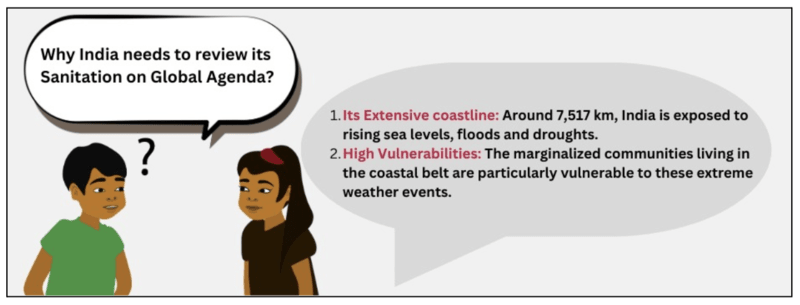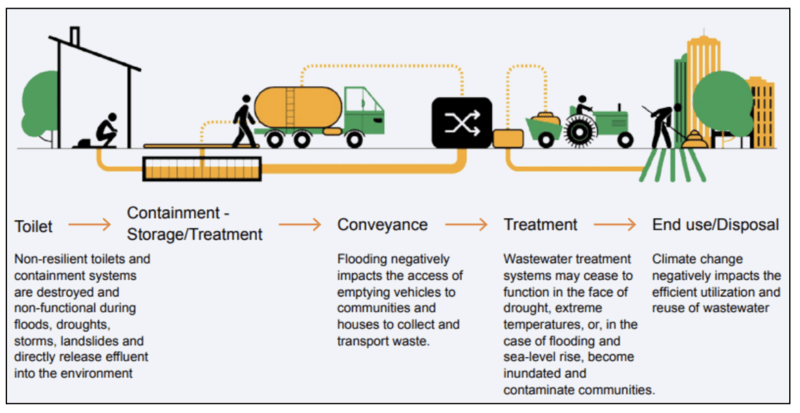It is not Sanitation but climate-proof sanitation
News Excerpt:
At the recent G20 summit in New Delhi, world leaders reiterated their previous commitment to addressing climate change challenges by building sustainable and appropriate solutions.

What is Climate-proof or Climate-resilient Sanitation?
- According to UNICEF, Climate-resilient sanitation refers to sanitation systems - both non-sewered and sewered).
- The services and behaviours that can survive, function or quickly recover in the face of a range of climate-related shocks, chronic stresses and seasonal variabilities, ensuring that faecal matter is safely contained throughout the sanitation service chain and does not contaminate the environment, emit excessive GHGs or cause risk to public health.
- Ideally, climate-resilient sanitation adapts to both climate change and simultaneously mitigates contributions to climate change.

Issues faced due to Non-resilient Sanitation:
- Sanitation and Greenhouse gas emission: According to the UNICEF 2022 report, the global methane emissions from non-sewered sanitation systems are equivalent to approximately 377 metric tons of carbon dioxide per year, or 4.7% of global anthropogenic methane emissions.
- Increase in Migration: The impact of climate change is leading to a growing number of displaced people. These people often resettle in areas of higher climate risk and poor access to WASH (water, sanitation, and hygiene) facilities or increase the burden on already overstretched facilities.
- Contamination of Natural Resources: Non-resilient sanitation directly releases effluent containing nitrogen and phosphorus from human urine and faeces into the environment during heavy rain and flooding periods. In addition to contaminating drinking water, this can also lead to eutrophication, where significant nutrient imbalances across ecological systems promote algae growth and deplete oxygen in water systems.
-
- Wetlands, coastal areas, and coral reefs are particularly vulnerable to the impacts of poorly managed sanitation, affecting the communities and ecosystems.
- Increase in Epidemics: The spread of diseases adds another layer of challenges, with 80% of slum residents in Bhubaneswar and 63% in Jaipur reporting fever, skin infections, malaria, dengue and typhoid, loss of livelihood, with economic instability and increased healthcare costs.
- Women and girls suffered the most, grappling with menstrual hygiene challenges and facing harassment while relieving themselves due to the lack of home toilets.

What is the Significance of Climate-resilient Sanitation?
- Behavioural change: Strengthening climate resiliency and behaviours along the whole sanitation service chain is likely to improve community resilience and lessen the impact of climate change.
- Protection and rapid recovery: Climate-resilient sanitation protects the entire service chain. It is resistant to damage from climate events, enables rapid recovery, and reduces GHG emissions.
- Climate-resilient sanitation encompasses both mitigation and adaptation. Mitigation involves reducing the emission of GHGs, while adaptation refers to minimising the impacts of climate events on sanitation service delivery.
Government Initiatives:
- WASH programming: India has made rapid progress in ending open defecation across the country, which significantly impacts improving water, sanitation, and hygiene (WASH).
- UNICEF extended the objective of eradicating open defecation to effective solid and liquid waste management in all cities and villages.
- By 2019, according to the latest estimates, the number of people without access to toilets has reduced significantly by an estimated 450 million.
- Swachh Bharat Sanitation Programme: The concept of Swachh Bharat Abhiyan is to provide basic sanitation facilities like toilets, solid and liquid waste disposal systems, village cleanliness, and safe and adequate drinking water supply to every Indian citizen.
- Core 6 components of this mission: Individual household toilets, Community toilets, Public toilets, Municipal Solid Waste Management, Information and Education Communication (IEC), Public Awareness, and Capacity Building.
- Jal Jeevan missions: This program aims to supply 55 litres of water to each citizen residing in rural households by providing extensive and functional Household Tap Connections (FHTC) by 2024.
- Rainwater harvesting and water conservation are also the most essential aspects of the mission, focusing on planting trees.
- Despite India having the policy framework for WASH-related policies in flagship missions such as the Swachh Bharat and Jal Jeevan missions, the country still needs to develop a climate-resilient WASH infrastructure and sustainable practices.
Way Forward:
- Need for Universal Integration and Collaboration: Integrating climate-resilient sanitation into national policies, legislation, and plans to integrate climate-resilient sanitation into national policies, legislation, and plans is a crucial first step in ensuring these climate-resilient programs and mitigation solutions can be taken to scale.
- Enhancing sustainable capacity: Governments can further strengthen people’s initiatives by strengthening their ability to sustain safe sanitation and incentivising them to revive alternative water sources. For example, adapt or design new sanitation systems and high-quality construction standards, methods, and materials (including roofing) in flood-prone areas.
- Need to minimise damage: This may include developing a market for elevated latrines, with accessibility ramps, that are both resistant to flooding and accessible for persons with disabilities.
- Need for Climate-resilient sanitation criteria:
- Risk analysis (hazard, exposure, vulnerability, and capacity) identifies potential impacts of climate and extreme weather events, and preventive measures have been incorporated.
- Mitigation measures are identified and implemented to reduce the risk of sanitation system failure.
- Sanitation services and systems are designed for reliability, flexibility, robustness, and responsiveness to seasonal variability and extreme weather events (e.g., during droughts/ floods) or quick recovery after a shock.
- Contingency plans and capacity are in place to anticipate, cope with, and respond to climate shocks while ensuring minimal service disruption.
Climate-resilient Sanitation is a solution that can reduce emissions and increase the health, well-being, and resilience of communities and the ecosystems on which we all depend.
BEYOND EDITORIAL:
Constitutional provisions related to Clean Environment and Sanitation:
- Seventh Schedule: The responsibility for providing drinking water supply and sanitation services falls under the purview of state governments, as outlined in the State List of the Seventh Schedule.
- Fundamental Rights: The Constitution of India under part III guarantees fundamental rights essential for the development of every individual and to which a person is inherently entitled by being human alone. Articles 21, 14, and 19 of this part have been used for environmental protection.
- Article 21 has received liberal interpretation from time to time after the Supreme Court's decision in Maneka Gandhi vs. Union of India. Article 21 guarantees the fundamental right to life. The right to an environment free of danger of disease and infection is inherent in it. The right to a healthy environment is essential to the right to live with human dignity.
- Fundamental Duty: Article 51-A (g) says that “It shall be the duty of every citizen of India to protect and improve the natural environment including forests, lakes, rivers, and wildlife and to have compassion for living creatures.”
- DPSP: The Directive principles under the Indian Constitution are directed towards the ideals of building a welfare state. A healthy environment is also one of the elements of the welfare state.
- Article 47 provides that the State shall regard raising the level of nutrition and the standard of living of its people and improving public health as among its primary duties. The improvement of public health also includes the protection and improvement of the environment, without which public health cannot be assured.
- Article 48 deals with the organisation of agriculture and animal husbandry. It directs the state to take steps to organise agriculture and animal husbandry along modern and scientific lines. In particular, steps should be taken to preserve and improve the breeds and prohibit the slaughter of cows and calves and other milch and draught cattle.
- Article 48 -A of the Constitution says that “the state shall endeavour to protect and improve the environment and to safeguard the forests and wildlife of the country”.
- The 74th Constitutional Amendment: It mandated the devolution of these services to the Urban Local Bodies (ULBs).
Mains PYQ
Q. ‘To ensure effective implementation of policies addressing water, sanitation, and hygiene needs, the identification of beneficiary segments is to be synchronized with the anticipated outcomes’ Examine the statement in the context of the WASH scheme. (UPSC 2017)
Q. What are ‘Smart Cities’? examine their relevance for urban development in India. Will it increase rural-urban differences? Give arguments for ‘Smart Villages’ in the light of PURA and RURBAN Mission. (UPSC 2016)
Prelims PYQ
Q. With reference to WaterCredit’, consider the following statements:
- It puts microfinance tools to work in the water and sanitation sector.
- It is a global initiative launched under the aegis of the World Health Organization and the World Bank.
- It aims to enable poor people to meet their water needs without depending on subsidies.
Which of the statements given above are correct?
(a). 1 and 2 only
(b). 2 and 3 only
(c). 1 and 3 only
(d). 1, 2 and 3

